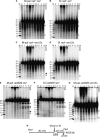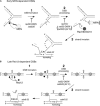A novel recombination pathway initiated by the Mre11/Rad50/Nbs1 complex eliminates palindromes during meiosis in Schizosaccharomyces pombe
- PMID: 15654094
- PMCID: PMC1449568
- DOI: 10.1534/genetics.104.037515
A novel recombination pathway initiated by the Mre11/Rad50/Nbs1 complex eliminates palindromes during meiosis in Schizosaccharomyces pombe
Abstract
DNA palindromes are rare in humans but are associated with meiosis-specific translocations. The conserved Mre11/Rad50/Nbs1 (MRN) complex is likely directly involved in processing palindromes through the homologous recombination pathway of DNA repair. Using the fission yeast Schizosaccharomyces pombe as a model system, we show that a 160-bp palindrome (M-pal) is a meiotic recombination hotspot and is preferentially eliminated by gene conversion. Importantly, this hotspot depends on the MRN complex for full activity and reveals a new pathway for generating meiotic DNA double-strand breaks (DSBs), separately from the Rec12 (ortholog of Spo11) pathway. We show that MRN-dependent DSBs are formed at or near the M-pal in vivo, and in contrast to the Rec12-dependent breaks, they appear early, during premeiotic replication. Analysis of mrn mutants indicates that the early DSBs are generated by the MRN nuclease activity, demonstrating the previously hypothesized MRN-dependent breakage of hairpins during replication. Our studies provide a genetic and physical basis for frequent translocations between palindromes in human meiosis and identify a conserved meiotic process that constantly selects against palindromes in eukaryotic genomes.
Figures



Similar articles
-
Nonhomologous End-Joining with Minimal Sequence Loss Is Promoted by the Mre11-Rad50-Nbs1-Ctp1 Complex in Schizosaccharomyces pombe.Genetics. 2017 May;206(1):481-496. doi: 10.1534/genetics.117.200972. Epub 2017 Mar 14. Genetics. 2017. PMID: 28292918 Free PMC article.
-
Release of Ku and MRN from DNA ends by Mre11 nuclease activity and Ctp1 is required for homologous recombination repair of double-strand breaks.PLoS Genet. 2011 Sep;7(9):e1002271. doi: 10.1371/journal.pgen.1002271. Epub 2011 Sep 8. PLoS Genet. 2011. PMID: 21931565 Free PMC article.
-
Ctp1 and Exonuclease 1, alternative nucleases regulated by the MRN complex, are required for efficient meiotic recombination.Proc Natl Acad Sci U S A. 2009 Jun 9;106(23):9356-61. doi: 10.1073/pnas.0902793106. Epub 2009 May 22. Proc Natl Acad Sci U S A. 2009. PMID: 19470480 Free PMC article.
-
A curious new role for MRN in Schizosaccharomyces pombe non-homologous end-joining.Curr Genet. 2018 Apr;64(2):359-364. doi: 10.1007/s00294-017-0760-1. Epub 2017 Oct 10. Curr Genet. 2018. PMID: 29018935 Free PMC article. Review.
-
Phosphorylation-regulated binding of Ctp1 to Nbs1 is critical for repair of DNA double-strand breaks.Cell Cycle. 2010 Apr 15;9(8):1516-22. doi: 10.4161/cc.9.8.11260. Epub 2010 Apr 15. Cell Cycle. 2010. PMID: 20421724 Free PMC article. Review.
Cited by
-
Role of the Mre11 Complex in Preserving Genome Integrity.Genes (Basel). 2018 Nov 29;9(12):589. doi: 10.3390/genes9120589. Genes (Basel). 2018. PMID: 30501098 Free PMC article. Review.
-
Homologous Recombination Defective Arabidopsis Mutants Exhibit Enhanced Sensitivity to Abscisic Acid.PLoS One. 2017 Jan 3;12(1):e0169294. doi: 10.1371/journal.pone.0169294. eCollection 2017. PLoS One. 2017. PMID: 28046013 Free PMC article.
-
Distinct requirements for the Rad32(Mre11) nuclease and Ctp1(CtIP) in the removal of covalently bound topoisomerase I and II from DNA.Mol Cell. 2009 Jan 16;33(1):117-23. doi: 10.1016/j.molcel.2008.11.021. Mol Cell. 2009. PMID: 19150433 Free PMC article.
-
Highly conserved regimes of neighbor-base-dependent mutation generated the background primary-structural heterogeneities along vertebrate chromosomes.PLoS One. 2008 May 14;3(5):e2145. doi: 10.1371/journal.pone.0002145. PLoS One. 2008. PMID: 18478116 Free PMC article.
-
Increased meiotic crossovers and reduced genome stability in absence of Schizosaccharomyces pombe Rad16 (XPF).Genetics. 2014 Dec;198(4):1457-72. doi: 10.1534/genetics.114.171355. Epub 2014 Oct 6. Genetics. 2014. PMID: 25293972 Free PMC article.
References
-
- Boddy, M. N., P.-H. L. Gaillard, W. H. McDonald, P. Shanahan, J. R. Yates et al., 2001. Mus81-Eme1 are essential components of a Holliday junction resolvase. Cell 107: 537–548. - PubMed
Publication types
MeSH terms
Substances
Grants and funding
LinkOut - more resources
Full Text Sources
Other Literature Sources
Molecular Biology Databases
Research Materials
Miscellaneous

